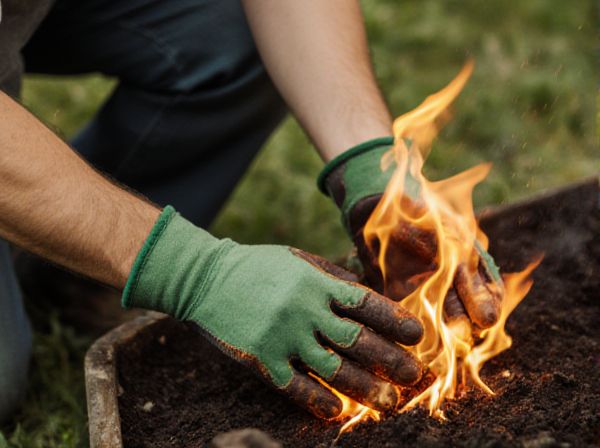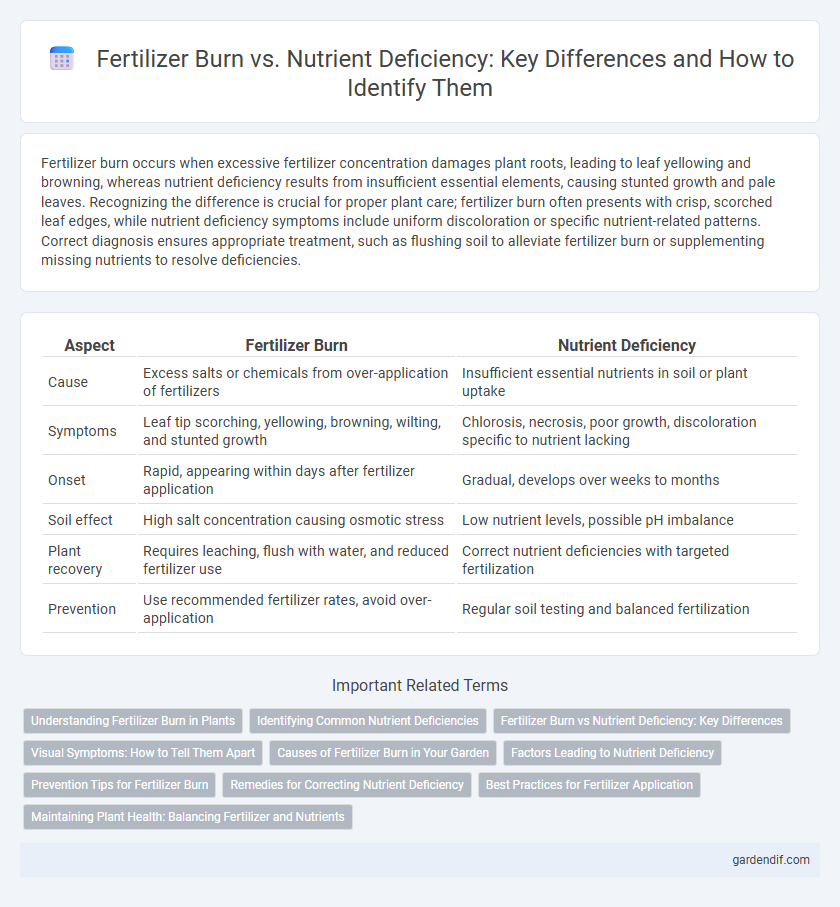
Fertilizer burn vs Nutrient deficiency Illustration
Fertilizer burn occurs when excessive fertilizer concentration damages plant roots, leading to leaf yellowing and browning, whereas nutrient deficiency results from insufficient essential elements, causing stunted growth and pale leaves. Recognizing the difference is crucial for proper plant care; fertilizer burn often presents with crisp, scorched leaf edges, while nutrient deficiency symptoms include uniform discoloration or specific nutrient-related patterns. Correct diagnosis ensures appropriate treatment, such as flushing soil to alleviate fertilizer burn or supplementing missing nutrients to resolve deficiencies.
Table of Comparison
| Aspect | Fertilizer Burn | Nutrient Deficiency |
|---|---|---|
| Cause | Excess salts or chemicals from over-application of fertilizers | Insufficient essential nutrients in soil or plant uptake |
| Symptoms | Leaf tip scorching, yellowing, browning, wilting, and stunted growth | Chlorosis, necrosis, poor growth, discoloration specific to nutrient lacking |
| Onset | Rapid, appearing within days after fertilizer application | Gradual, develops over weeks to months |
| Soil effect | High salt concentration causing osmotic stress | Low nutrient levels, possible pH imbalance |
| Plant recovery | Requires leaching, flush with water, and reduced fertilizer use | Correct nutrient deficiencies with targeted fertilization |
| Prevention | Use recommended fertilizer rates, avoid over-application | Regular soil testing and balanced fertilization |
Understanding Fertilizer Burn in Plants
Fertilizer burn occurs when excessive salts from over-application of fertilizers cause dehydration and leaf scorching in plants, contrasting with nutrient deficiency where specific nutrient absence leads to stunted growth and chlorosis. High concentrations of nitrogen, potassium, or phosphorus can disrupt water uptake, resulting in symptoms like browning leaf edges and wilting, which differ from deficiency signs such as pale leaves or poor development. Monitoring soil nutrient levels and following precise fertilizer guidelines helps prevent burn, ensuring optimal plant health and nutrient balance.
Identifying Common Nutrient Deficiencies
Fertilizer burn often results from excessive application, causing leaf scorch and plant stress, whereas nutrient deficiencies manifest as specific symptoms like yellowing (chlorosis), stunted growth, or poor fruit development. Common nutrient deficiencies include nitrogen (yellowing older leaves), phosphorus (dark green leaves with purple tints), and potassium (leaf margins browning). Accurate identification using leaf tissue analysis and soil testing helps differentiate between fertilizer burn and nutrient deficiencies for targeted treatment.
Fertilizer Burn vs Nutrient Deficiency: Key Differences
Fertilizer burn occurs when excessive salts from over-application damage plant roots, leading to leaf scorch and stunted growth, while nutrient deficiency results from insufficient essential nutrients causing specific symptoms like yellowing leaves or poor development. The key differences lie in the cause and visual symptoms; fertilizer burn often presents as marginal leaf browning due to salt toxicity, whereas nutrient deficiency shows uniform discoloration or malformations linked to the lacking nutrient. Understanding these distinctions helps in diagnosing plant health issues accurately and tailoring corrective actions such as adjusting fertilizer rates or supplementing missing nutrients.
Visual Symptoms: How to Tell Them Apart
Fertilizer burn presents as brown, dry leaf edges or tips caused by excess salts damaging plant roots, while nutrient deficiency symptoms vary depending on the lacking element, such as yellowing leaves in nitrogen deficiency or purpling in phosphorus deficiency. Fertilizer burn often affects the newest growth first, whereas nutrient deficiencies typically show on older leaves initially. Recognizing these distinct visual symptoms helps differentiate between toxic over-fertilization and true nutrient shortage in plants.
Causes of Fertilizer Burn in Your Garden
Fertilizer burn in your garden is primarily caused by applying excessive amounts of fertilizer, leading to high salt concentration in the soil that draws moisture away from plant roots. Using fertilizers with high nitrogen or potassium levels without proper dilution or application guidelines increases the risk of tissue damage and root dehydration. Salts from synthetic fertilizers accumulate, causing osmotic stress and disrupting nutrient uptake, which can be mistaken for signs of nutrient deficiency.
Factors Leading to Nutrient Deficiency
Poor soil quality, improper pH levels, and insufficient organic matter are primary factors leading to nutrient deficiency in plants. Fertilizer burn occurs when excess fertilizer salts cause root damage, yet nutrient deficiency typically arises from inadequate nutrient availability or uptake. Environmental stressors such as drought and heavy rainfall can also reduce nutrient absorption, exacerbating deficiency symptoms.
Prevention Tips for Fertilizer Burn
To prevent fertilizer burn, apply fertilizers at recommended rates and avoid over-application, especially with high-salinity products like ammonium nitrate. Ensure soil is well-moisturized before and after fertilization to help nutrients absorb properly and reduce salt concentration near roots. Regularly test soil nutrient levels to tailor fertilizer type and quantity, minimizing the risk of both burn and nutrient deficiency.
Remedies for Correcting Nutrient Deficiency
Correcting nutrient deficiency in plants involves applying balanced fertilizers with essential macro- and micronutrients such as nitrogen, phosphorus, potassium, calcium, magnesium, and iron. Soil testing helps determine specific nutrient shortages to tailor appropriate amendments like chelated micronutrients or organic compost for improving nutrient availability. Ensuring proper watering and avoiding over-fertilization prevents further stress and promotes optimal nutrient uptake for healthy plant growth.
Best Practices for Fertilizer Application
Fertilizer burn occurs when excessive nutrient concentration damages plant roots, leading to wilting and leaf scorch, while nutrient deficiency manifests as stunted growth and chlorosis due to insufficient essential elements. Best practices for fertilizer application include precise soil testing to determine nutrient requirements, using calibrated equipment for uniform distribution, and applying fertilizers at recommended rates to prevent toxicity. Incorporating organic matter and following split applications during the growing season enhance nutrient uptake and minimize the risk of both fertilizer burn and deficiency.
Maintaining Plant Health: Balancing Fertilizer and Nutrients
Properly balancing fertilizer application is crucial to prevent fertilizer burn, which occurs when excessive salts damage plant roots, leading to symptoms like leaf scorch and stunted growth. Nutrient deficiency, on the other hand, manifests as yellowing leaves, poor development, and reduced yield due to insufficient essential elements like nitrogen, phosphorus, or potassium. Regular soil testing and precise nutrient management ensure plants receive adequate nutrients without over-fertilization, maintaining optimal health and promoting robust growth.
Fertilizer burn vs Nutrient deficiency Infographic

 gardendif.com
gardendif.com